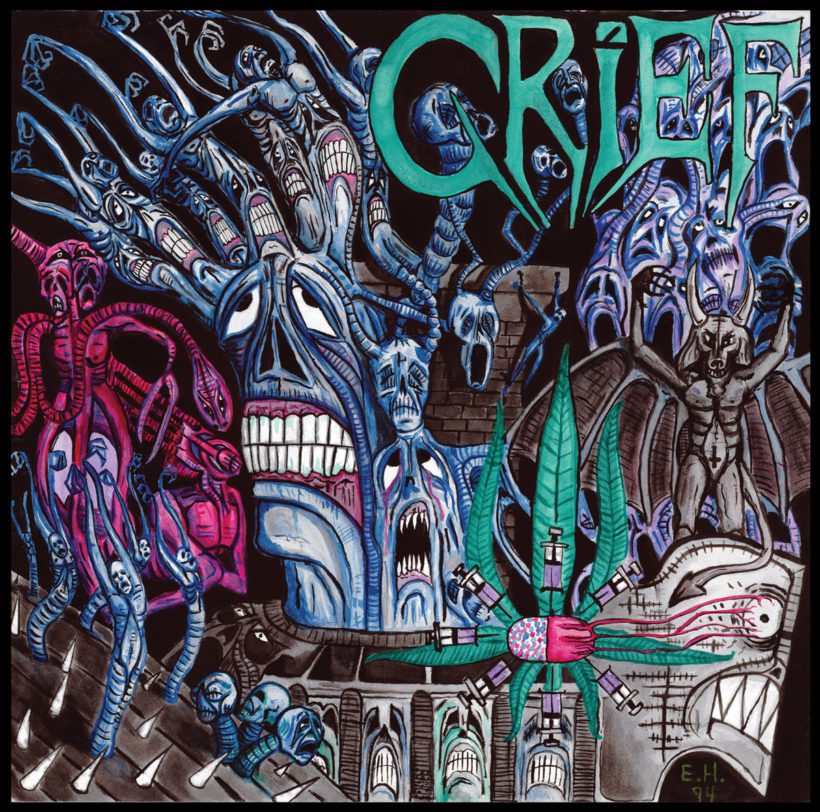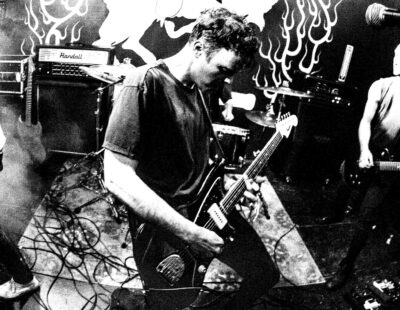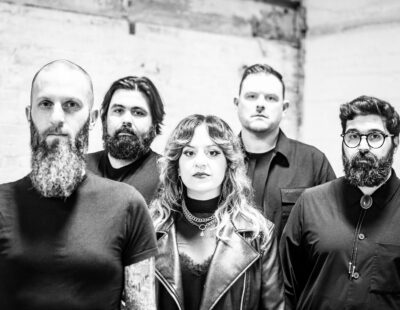
In our May 2018 issue, we had the pleasure of inducting Grief‘s sludgey debut album from 1994, Come to Grief, into our Hall of Fame. Because the Grief guys had plenty to say, and we had plenty to ask them, the original version of that story ran 2000 words longer than it should have, and we had to chop pretty mercilessly to make it fit.
So here’s a little bonus, a small addition to the magazine’s lengthy, in-depth examination of the album, in the form of the material that we cut out to make it fit in our pages.
Grief’s lineup on Come to Grief was Jeff Hayward on guitar and vocals (up until this album, he was just singing), Terry Savastano on guitars, Randy Odierno on bass (he would later switch to drums), and Rick Johnson on drums. Read on to see what they had to say about how the album was received when it came out, how the material on it was a progression from their earlier, non-album releases, and more.
Enjoy, and don’t forget to grab a copy of the magazine right here to read much, much more about the making of this underground classic.
There wasn’t much like Come to Grief at the time. How was the album received when it came out?
Jeff Hayward: I’d say pretty mixed, I think. Around here and our hometown, we didn’t do well. We really had a hard time getting shows. No one would book us, so we didn’t play much around here in the early ’90s. We would do well going to New York, we played there a lot, we’d go down to Rhode Island all the time, Providence was only an hour away. We were friends with the dudes in Dropdead, we knew them from the Disrupt years. But we weren’t received very well in our hometown; we’d play shows and it’d be like our girlfriends… there’d be nobody there. 15 people. Funny how it all works out; after we break up, everyone’s like, “Oh, get the band back together.” Boston, back in those days, was a hardcore town; no one was doing this in our neighbourhood. But we did okay; at that time we were still pretty new, so we were making a little bit of a name for ourselves, but we certainly enjoyed getting out of Massachusetts more than playing around here. We did a tour on that record in ’95 with Extreme Noise Terror, we did about three weeks, we went all the way down the east coast to Florida, over to Texas, and up to Milwaukee and ended at the Milwaukee Metalfest. For the most part, the tour went pretty well. Like any tour, there was a couple of clunkers, couple shows got cancelled, and a little bit of dysfunction along the way. When you think of booking those tours… there was no computers, we were mailing letters to people booking shows; especially once we were on the road, shows would get cancelled out in Kansas, and we’re driving up in the middle of nowhere in the Midwest to get to a show, but the show’s cancelled, but there’s no way of us knowing. But all in all, it was fun.
Terry Savastano: Definitely mixed. I remember getting, I can’t even remember the name of it, it was a big slick music magazine, and it was odd shaped, I got it at Tower Records one time. They gave us an amazing review, man, like 10 out of 10. Shit, man: a big fucking magazine was freaking out over us. Then we get a smaller stapled zines saying, “This is way too slow,” or “Why are these guys so angry?” It was definitely mixed reviews. I’d say more people didn’t like it versus liked it [laughs]. No question about that. Because, like I say, this whole thing was very much in its infancy, and we were one of the first. For years, we played in front of five or 10 people going on tour. Now these sludge bands put a demo out and they’re in front of 300 people, you know what I mean? I don’t want to be conceited or nothin’, but I like to think that we’ve kind of laid the groundwork for certain bands. I hope so, anyway.
Rick Johnson: I think it went pretty well. I think people were kinda waiting on it, to be honest with you. Dismal and stuff like that, those went over pretty well. I’m not sure sales-wise, but I noticed in New York when we started playing shows, my first time playing CBGBs, like, I’d only ever heard about this place on TV and now I’m up on stage. Blondie, Talking Heads, and some of the greatest bands ever have played there, the Ramones and stuff like that. But, yeah, I noticed people there were really into it, and out south, it seemed that the more south we got, the more hicks that we ran into… for some reason they like the slower stuff.
Randy Odierno: If you look back at some of the reviews, they’re probably mixed. Again, around here, you never had a lot of people go, “Oh my god, this is the best thing ever,” because not a lot of people came to shows. But I can tell you that when we went on that tour with Extreme Noise Terror there was some people who knew the songs, so there was definitely people listening to it. If you look back on some of the reviews from back then, they’re funny [laughs]. A lot of them were like, “This is great,” and a lot of them were like, “It’s not really my cup of tea, it’s monotonous and it all sounds the same.” I guess that was the point. We weren’t trying to be a jazz band or something. We wanted to be monotonous and punishing, song after song. But I think it was received at the time probably 50/50, but, as you’ve seen, it’s grown on people over the years.
How did you feel about the album when it came out?
Hayward: I was really happy with it. I thought the songs were good, they were solid, I think the production of the record, everything, really… It’s my favorite of all the records we did. It might not be the most technically written record, as we went on it got a little more intricate with some of the guitar work and stuff. But I was very pleased with that record. The artwork, my friend Eric Harrison, who ended up in the band a few years later, he was doing artwork for us. I always like his work, it was pretty unique and original. I was really happy with that record.
Savastano: I was absolutely blown away by it. To this day, it’s still definitely in my top two or three greatest accomplishments of my life. This album, Disrupt’s Unrest album, and the record that I just put out with my band Come to Grief, The Worst of Times, those are definitely my three greatest musical achievements. You know, you get a lot of artists who say, “I haven’t done my best record yet,” or, “My best record is still years in the future.” For me, man, I swear, in a lot of ways, I have accomplished that. It’s definitely my favorite Grief record, period, and it’s definitely one of the greatest things I’ve ever done, no doubt about that.
Johnson: Oh, dude, I was excited. I’ve always been that way. Every time I’ve done a project, I’ve always tried to make it professional. I’ve always liked to hear myself sound good and listen to it back. When I first heard it completely done, I think we listened to it in a car to see what kind of sound we were going to get out of a tape deck or CD player. It gave me chills. I think it came out great, and as far as Bill T. Miller doing production, every time we went with that guy no matter where the studio was, he asked us to plug in and get the sound that we wanted through the amps and he’d mimic it through the system. He’d tweak it here and there; there’s production on the album, but he didn’t really have to screw with it too much sound-wise. The way it came out, I was happy, that’s for sure.
Odierno: I felt then and I still feel now that it was the best thing ever. I know Jeff has said it’s his favorite Grief album. It’s definitely my favorite for a variety of reasons. They’re all good; even the one I didn’t play drums on, …And Man Will Become the Hunted, is a great freakin’ album. But this one, out of all of them, it’s my favorite. The production on it is warm and fat, I don’t know if it’s just that studio. You’ve heard the album: it sounds really analoguey, everything sounds big, all the instruments sound good. It just captures that moment in time perfectly.
How do you feel the album was a step ahead from the material you had released before it?
Savastano: We definitely put more into the songwriting, no question about that. We put out the Dismal 12”, we put out a 7”, we put out splits, I really looked at [Come to Grief] as a full-length album. I really wanted to do a whole package, seven or eight songs, I wanted it to be packaged well, I wanted it to flow like an album, and I think it does. You’ve got the song “Come to Grief” as the last song, “Earthworm” is the first song, I think it’s formatted really good as an album. I think we grew as musicians, as writers, as artists, in that small time span. We put more effort into it, we concentrated more, more thought went into the whole process.
Johnson: I don’t know, I guess more modern doom [laughs]. I think it was just a project where they were trying something new and it worked. The more I listen to music nowadays, I’m getting more into old ’70s rock, there actually are bands that sounded like us, I just never heard them. It’s kind of bizarre, like, oh boy, there actually was someone doing this before us, I just never heard it. It may not be the same, but it’s pretty close.
Hayward: I think, like any band, as you keep playing and writing together, stuff keeps coming together. That’s the thing with Grief, everyone wrote. Rick didn’t really write any of those songs, but Randy could write, I wrote, Terry wrote, even Jay [Stiles] and Pete [Donovan], who were in the original lineup… Everyone wrote songs, so we always had a good dynamic. But, yeah, as you go, you develop. I think as we started, things were pretty basic, the first 7”, there’s some pretty simple songs, two or three riffs or something. But by the time we were writing the Come to Grief record, we were expanding it as far as the songwriting goes, trying to get a little more not super basic caveman shit [laughs]. You try to concentrate on the riff. I’m real picky about when I write a riff, if I keep playing it and it’s boring or there’s nothing special about it, I’ll just move on and try to write something else. I think with most songs, if the riff’s good, you’re on to something.
Odierno: If you compare, say, the first 7” to that, they’re starting to get a little more interesting [laughs], I guess you could say. But even with that, they were only slightly more involved than the ones on the 7” or some of those splits, like “Falling Apart” [from the split 7” with 13] or the stuff that’s on Dismal. If you listen to all of it, it follows the same basic formula, it just has much better production. It drives it all home because the production is so good. I’d say that the songs in general are probably heavier than some of the earlier songs. But again, I think it was the overall aura and the sound of the album was what made it, in addition to the songs themselves. The whole package is what did it, you know?






